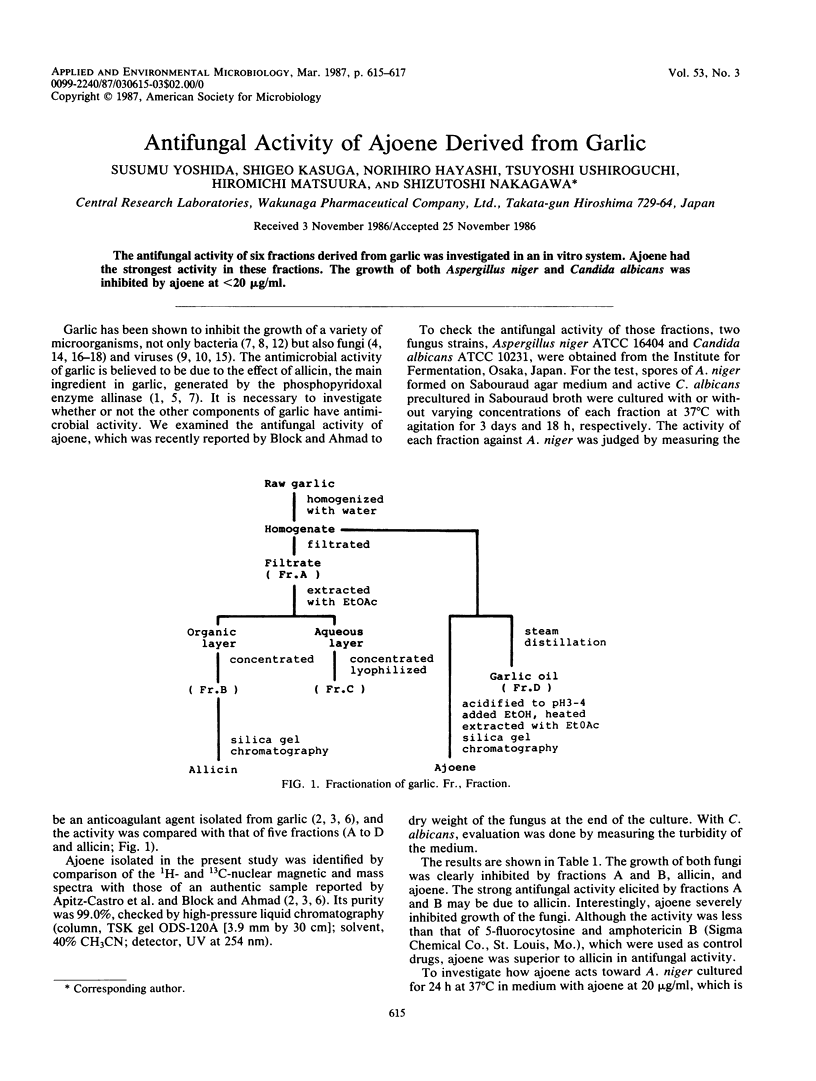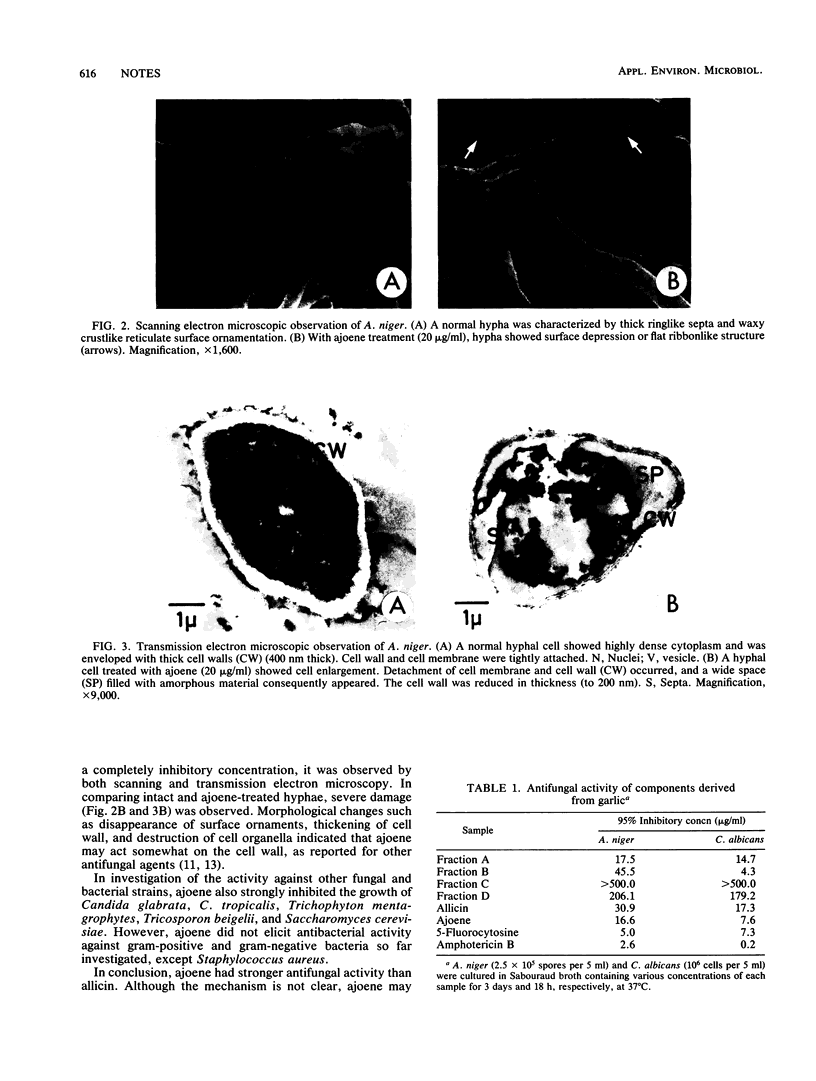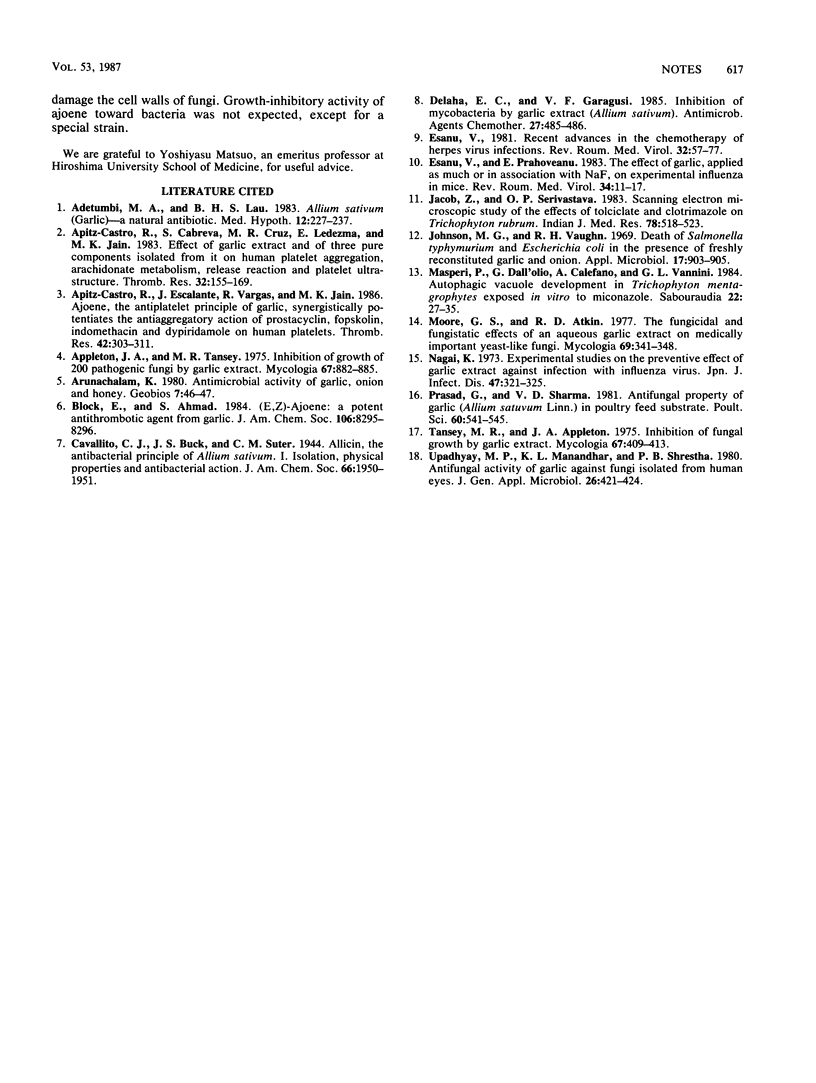Abstract
The antifungal activity of six fractions derived from garlic was investigated in an in vitro system. Ajoene had the strongest activity in these fractions. The growth of both Aspergillus niger and Candida albicans was inhibited by ajoene at less than 20 micrograms/ml.
Full text
PDF


Images in this article
Selected References
These references are in PubMed. This may not be the complete list of references from this article.
- Adetumbi M. A., Lau B. H. Allium sativum (garlic)--a natural antibiotic. Med Hypotheses. 1983 Nov;12(3):227–237. doi: 10.1016/0306-9877(83)90040-3. [DOI] [PubMed] [Google Scholar]
- Apitz-Castro R., Cabrera S., Cruz M. R., Ledezma E., Jain M. K. Effects of garlic extract and of three pure components isolated from it on human platelet aggregation, arachidonate metabolism, release reaction and platelet ultrastructure. Thromb Res. 1983 Oct 15;32(2):155–169. doi: 10.1016/0049-3848(83)90027-0. [DOI] [PubMed] [Google Scholar]
- Apitz-Castro R., Escalante J., Vargas R., Jain M. K. Ajoene, the antiplatelet principle of garlic, synergistically potentiates the antiaggregatory action of prostacyclin, forskolin, indomethacin and dypiridamole on human platelets. Thromb Res. 1986 May 1;42(3):303–311. doi: 10.1016/0049-3848(86)90259-8. [DOI] [PubMed] [Google Scholar]
- Appleton J. A., Tansey M. R. Inhibition of growth of zoopathogenic fungi by garlic extract. Mycologia. 1975 Jul-Aug;67(4):882–885. [PubMed] [Google Scholar]
- Delaha E. C., Garagusi V. F. Inhibition of mycobacteria by garlic extract (Allium sativum). Antimicrob Agents Chemother. 1985 Apr;27(4):485–486. doi: 10.1128/aac.27.4.485. [DOI] [PMC free article] [PubMed] [Google Scholar]
- Eşanu V., Prahoveanu E. The effect of garlic extract, applied as such or in association with NaF, on experimental influenza in mice. Virologie. 1983 Jan-Mar;34(1):11–17. [PubMed] [Google Scholar]
- Jacob Z., Srivastava O. P. Scanning electron microscopic study of the effects of tolciclate & clotrimazole on Trichophyton rubrum. Indian J Med Res. 1983 Oct;78:518–523. [PubMed] [Google Scholar]
- Johnson M. G., Vaughn R. H. Death of Salmonella typhimurium and Escherichia coli in the presence of freshly reconstituted dehydrated garlic and onion. Appl Microbiol. 1969 Jun;17(6):903–905. doi: 10.1128/am.17.6.903-905.1969. [DOI] [PMC free article] [PubMed] [Google Scholar]
- Masperi P., Dall'Olio G., Calefano A., Vannini G. L. Autophagic vacuole development in Trichophyton mentagrophytes exposed in vitro to miconazole. Sabouraudia. 1984;22(1):27–35. [PubMed] [Google Scholar]
- Moore G. S., Atkins R. D. The fungicidal and fungistatic effects of an aqueous garlic extract on medically important yeast-like fungi. Mycologia. 1977 Mar-Apr;69(2):341–348. [PubMed] [Google Scholar]
- Nagai K. [Preventive effect of garlic extract against influenza]. Kansenshogaku Zasshi. 1973 Sep;47(9):321–325. doi: 10.11150/kansenshogakuzasshi1970.47.321. [DOI] [PubMed] [Google Scholar]
- Tansey M. R., Appleton J. A. Inhibition of fungal growth by garlic extract. Mycologia. 1975 Mar-Apr;67(2):409–413. [PubMed] [Google Scholar]




